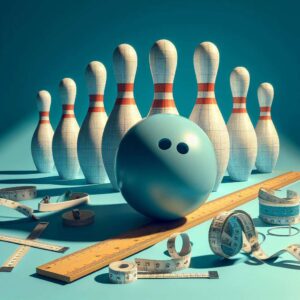Bowling is one of America’s most popular recreational sports with over 70 million participants taking to the lanes every year. However, repetitive motions like bowling can take a toll on muscles and joints.
Understanding common bowling injuries, prevention tactics, and proper treatment can help you minimize pain and disruption from injuries. That way, you keep enjoying the sport you love rather than sitting it out.
In this comprehensive guide, we’ll cover:
- The most widespread bowling injuries bowlers suffer and what causes them
- Tips to help avoid the most common bowling maladies
- The best treatment plans for recovering from strains, sprains, and swelling
- Smart strategies to return to the lanes safely after healing up
Arm yourself with proactive knowledge so you can keep striking out those pesky pins for years to come!
The Most Prevalent Bowling Injuries and Their Causes
Bowling may seem like a safe, low-impact activity but the repeated motions match those in sports with high rates of injury. Without proper care for your body, you risk hurting your fingers, wrists, knees, back, and elbows. Understanding the vulnerable areas for bowlers reduces surprise when common aches and pains occur.
Wrist Sprains
Flicking the wrist rapidly on each bowling swing puts tremendous strain on tendons and ligaments. Attempting hook shots and not properly supporting these delicate joints also heightens risk. Bowlers often ignore building wrist endurance and flexibility until injury strikes.
Sprains happen when a fall or awkward turn overstretches a joint and tears the ligaments encompassing it. Swelling and bruising make it difficult to pivot or grip objects without sharp twinging. Resting is crucial so inflammation can subside and tiny muscle fiber tears knit back together.
Tendonitis
The tendons threading around your joints also withstand substantial burden during bowling. These fibrous cords attach your muscles to bones. When overused, they become inflamed and cause localized soreness. If bowling with existing tendonitis, you may irritate the condition.
Elbows and shoulders bear the brunt of tendonitis as bowlers’ arms rock back and forth relentlessly. Poor lifting form also tweaks delicate shoulder tendons. Without rest, mild tendonitis worsens to ruptured tissues or osteoarthritis long-term.
Lower Back Pain
Did you know over 70% of bowlers suffer lower back pain eventually? The lumbar region endures vigorous twisting with each roll towards the pins. If back muscles lack strength and you hyperextend reaching back, you risk strained tissues or herniated disks over time.
Vertebral compression causes debilitating spasms across the back. Hernias between disks impinge nerves emanating to your legs and feet, causing numbness or sciatica. Bulging or ruptured disks become chronic conditions without physical therapy. Strengthening core muscles prevents many back-blowing injuries.
Knee Damage
Knee pain plagues veteran bowlers through straining ligaments or meniscus tears in cartilage. The slide technique before your swing adds extra friction within the joint over years depending on the lane surface. Landing poorly from a jump turn or twist strains stabilizing ligaments.
Awkward falls and poor impact absorption also inflame irritated knee tissues. Continuous play without rest worsens minor tears into surgeries for ligament reconstruction or cartilage removal. Knee braces, taping, and padded shoes help but stretching IT bands and leg muscles better support joint integrity long-term.
Blisters
Even small irritations like blisters discourage bowlers losing their grip and control of the heavy sphere. Extended games create hot spots on fingers that filling bowling balls exacerbate through friction and repeated impact. Blood and skin seam separation forms tender, puffy lesions.
Advanced players strengthen hand skin’s durability but learning the right grip technique prevents many blisters. Ensuring your bowling ball fits correctly also avoids grip strain. Cover blisters with moleskin patches during play so they don’t rip open further or prevent your ability to hold the ball.
Now that you know where bowlers experience recurring injuries, let’s explore preventative care so you avoid trips to the doctor!
Injury Prevention Tips and Bowling Best Practices
Just a little foresight and some proactive strengthening keep the body resilient through hundreds of ice-slick swings over the years. Protect all the vulnerable zones prone to bowling’s wear and tear with these handy tips:
Wrist Support Solutions
The US Bowling Congress estimates 2/3rds of bowler injuries impact wrists and fingers. Don’t become another statistic! Stabilize these fragile joints against jarring impacts and overextension with pro supports.
Wrist braces significantly improve bowling performance by boosting strength and preventing hyperextension. Thumb braces also reinforce strain points. Tape-wrapping wrists before play also bolsters vulnerable tendons.
For acute wrist sprains, splinting immobilizes joints until ligaments heal. Use ice packs after play to reduce inflammation rather than heat, which exacerbates swelling.
Building Back and Core Strength
Chisel your body into a bowling fortress by building incredible back and core stability. Planks, bridges, squats with resistance bands, and yoga poses like child’s pose stretch and tone.
Strengthening exercises prevent compensation by other muscles when your core tires. Consistent training safeguards your spine against disc damage and painful spasms over years enjoying the lanes.
Proper Ball Fit
An essential yet oft-overlooked step to prevent finger, hand, and wrist strain comes long before setting foot in the alley. Confirm your ball fits accurately so you don’t bear excess pressure across vulnerable bones with an improper grip span.
Blisters come primarily from the concentrated friction of a bowling ball rubbing as you swing. Visiting your local pro shop ensures ideal fit adjustments suit your hand size to avoid excess abrasion and guard finger ligaments.
Warm Up and Cool Down
Just like other sports with repetitive strain, always warm up joints through full ranges of motion before bowling games. Relax muscles with foam rolling, massage, and gentle static stretches.
Cool downs after matches prevent next-day stiffness by transporting fluid and waste from stressed tissues. Low-intensity exercise like walking combined with refueling nutrition speeds muscle repair overnight.
Rest Days Are Required
While bowling looks low impact, realizing ligaments, joints, and muscles still require days off between games prevents overtraining. Don’t bowl with existing strains until fully healed or you prolong recovery. Scheduled rest every few matches keeps your body humming.
Now that you know how to avoid common pitfalls, what’s the game plan if you experience bowling injuries? Let’s break down treatments for getting you quickly back in action.
Treating Bowling Injuries: Recovery Tips for Each Area
Even bowlers diligent about preventative care occasionally deal with minor sprains or irritation. Understanding treatment options expedites healing so you miss fewer frames on the sidelines. Here are targeted remedies for nursing bowling’s most troublesome spots back to health:
Wrist Sprains
For painful wrist sprains, immediately begin RICE – rest, ice, compression, and elevation. Immobilizing strained ligaments speeds mending while icing controls inflammation. Wrap with an elastic bandage and prop up the wrist above heart level.
Over-the-counter NSAID medication like ibuprofen reduces swelling and discomfort short-term. After 48 hours, gentle circulation boosting activity facilitates injury site nutrition and waste removal. Physical therapists show tailored stretches and exercises to rebuild flexibility and strength before full bowling form resumes.
Tendonitis
The most effective tendonitis cure involves extended rest from the aggravating activity – up to 6 weeks for moderate cases. As inflammation subsides, stretch and massage forearm muscles to keep them flexible during downtime off the alley.
Chiropractors or sports medicine specialists may use ultrasound treatments to stimulate blood flow to strained tendons without taxing already inflamed tissue. Low-force laser therapy also reduces swelling with light technology.
Once pain abates, eccentric muscle training rebuilds flexibility and strength in the injured area. Start bowling again with lighter weights, limited wrist flicks, shorter games, and more rest days to avoid re-injury.
Back Pain
Craving back pain relief means knowing when to sit out games altogether. Stop bowling during painful back spasms and use ice for the first 2 days to reduce nerve irritation and inflammation. Walking, swimming, or gentle yoga help blood circulate around injured areas once acute pain passes.
Rest only temporarily fixes chronic back problems from muscular imbalances and poor body mechanics. Train with physical therapists or sports medicine professionals to build core, glute, and hamstring strength preventing disks and muscles from enduring excess strain. They’ll clear you for full activity when ready.
Knee Injuries
Allow mild knee ligament strains ample rest to prevent partial tears from becoming complete ruptures needing surgery. Ice, compression sleeves, and anti-inflammatory meds ease discomfort from inflammation and impact during recovery.
Protect healing ligaments with rigid braces or taping during activity. Avoid pain-provoking movements like kneeling or squatting that tweak injured fibers. Follow tailored PT to stretch resisting muscle groups around the knees and improve stability before upping bowling intensity.
Blisters
The adage “Don’t pop your blisters!” holds true to avoid infection inside sensitive finger joints. Clean blisters gently with antibacterial soap and cover them with a hydrogel bandage or moleskin to prevent friction from rubbing the raw wound.
Allow skin layers to reattach naturally before gripping bowling balls again or you risk repetition of the same hot spot. Build calluses gently over time once healed by bowling in shorter increments with tapes or gloves to prevent regression.
Returning to Bowling After Injury – Do’s and Don’ts
The final step after nursing strained bowling zones involves smartly integrating back into your favorite pastime. Follow these dos and don’ts when easing off the bench back into bowling:
Do…
✔ Check in with a doctor or physical therapist before returning to confirm injury resolution, flexibility, and strength.
✔ Tape or brace vulnerable joints as continued support when starting up again.
✔ Start back bowling slowly with lighter balls, fewer games, less torque, and more rest days.
✔ Pay attention to pain signals and stop if they indicate you’re overdoing activity.
✔ Continue preventative exercises for core and troublesome muscles like wrists and shoulders.
Don’t…
❌ Resume intense bowling tournaments right after injury recovery.
❌ Bowl multiple days in a row initially after extended rest for major injuries.
❌ Use maximum power and arm extension when just bouncing back.
❌ Dismiss recurring pain thinking it will just go away.
❌ Skip proper cool-down stretching and muscle care after return sessions.
The Antidote for Bowling’s Aches and Pains
While fanatical bowlers hate skipping frame after frame recovering from sprains or irritation, patience pays off long run. Let your body fully mend strained ligaments and aching joints before repeating moves exacerbating existing issues.
Pay attention and you’ll discover smart ways to adapt technique and preparation to play pain-free forever. Dedicate time towards targeted strengthening and flexibility outside bowling games to withstand their demands inside luminous, pin-filled alleys for years to come.
Implement our prevention and treatment tips so that striking down those stubborn 7-10 splits remains your biggest challenge on the lanes!
Frequently Asked Questions
What is a common injury in bowling?
Some of the most common bowling injuries are wrist sprains or fractures, swollen tendons or tendonitis in the elbows and shoulders, blisters on fingers, lower back strains, and knee ligament damage.
Can your body hurt from bowling?
Yes, the repetitive motions involved in bowling matches or long practice sessions can definitely make your body hurt if you don’t take proper precautions. Muscle soreness, joint pain, tendonitis, and ligament strains are common bowling injuries.
Can you pull a muscle while bowling?
It’s very possible to pull or strain a muscle while bowling. The sliding motion can strain muscles like the hamstring, groin muscle pulls can happen from awkward motions, and the repetitive swinging can strain muscles in the chest, shoulders, upper back, forearms, and hands.
Why does bowling hurt my legs?
Bowling can hurt your legs because of the slide step motion which repeatedly stresses leg and hip flexor muscles. Hamstring strains are also common if these muscles are forced to work too hard controlling the eccentric lowering of the slide. Impact pains come from poor landing biomechanics.
What are the most common fast bowling injuries?
For fast bowlers in cricket, common injuries include lumbar spine issues like slip discs from rotational force, shoulder tendonitis, knee ligament injuries, hamstring muscle strains from overstride, and wrist fractures if front-foot spins put torque on fragile wrist joints.
Is bowling bad for your arm?
Bowling without preventative care can be bad for your arms long-term. Repetitive stress with high force loads can cause elbow and shoulder tendonitis or impingement syndromes which spur osteoarthritis development later. Supporting good form and building strength prevents overuse issues.
How do you relieve bowling pain?
Ways to relieve bowling pain include ice packs to reduce inflammation, OTC NSAID meds, wrist braces, elbow/knee sleeves or taping for support, massage and stretching routines, building core and leg strength to stabilize joints, and taking ample rest periods to allow strained tissues to heal properly.
What muscles do you use when you bowl?
Major muscle groups used in bowling include shoulders, lats, chest and arms to swing the ball, abdominals and lower back to twist the spine, quadriceps and glutes to control the slide and swing, forearms and hand muscles to grip the ball, and wrists/fingers to impart speed and spin.
What is a common hip injury from bowling?
The most frequent hip injuries bowlers face are hip flexor strains from excessive sliding motion that repetitively lengthens these muscles. Poor hip hinge mechanics can also lead to general hip muscle soreness or even hip impingement syndromes if Femoroacetabular Impingement (FAI) exists.





